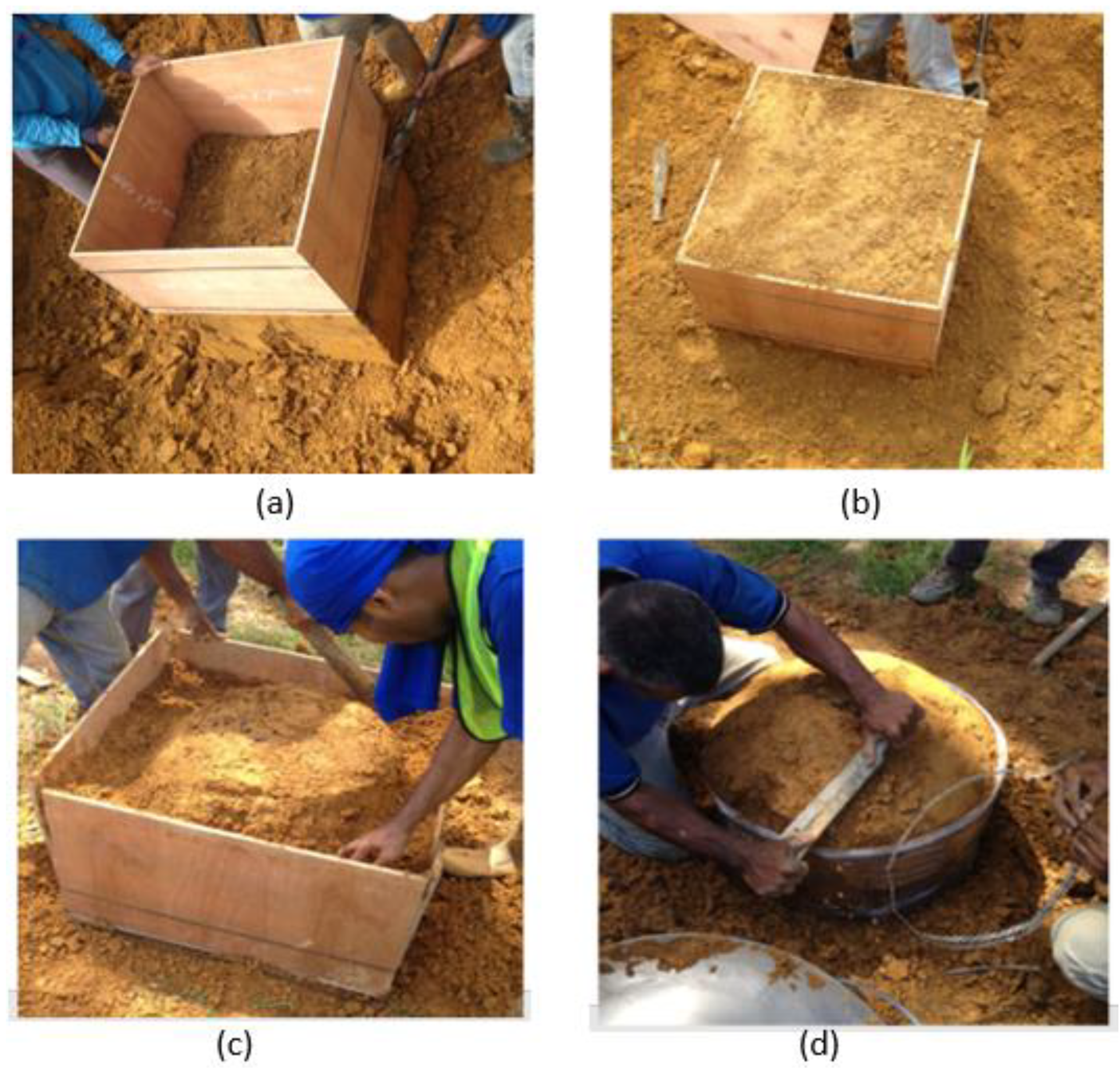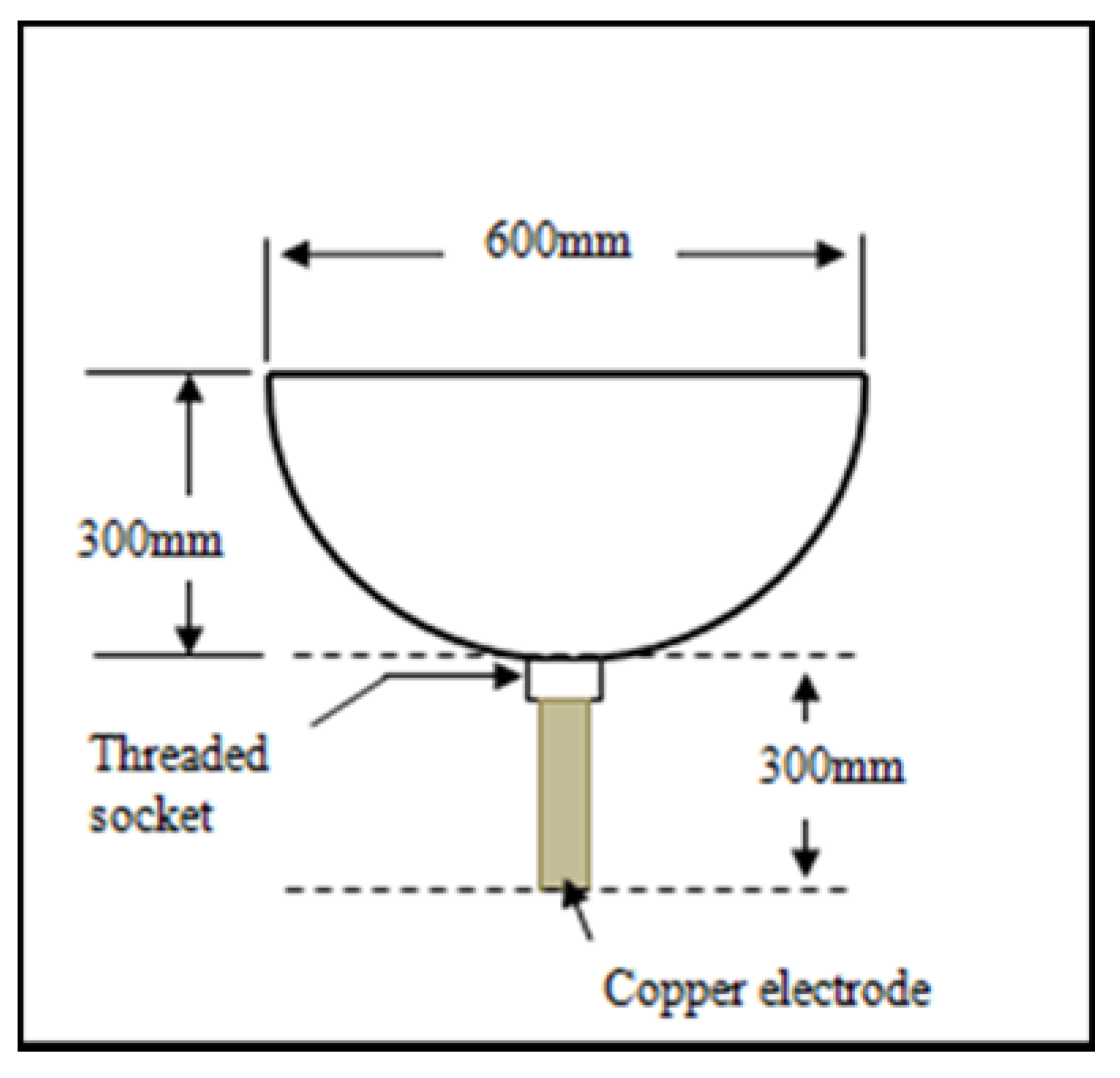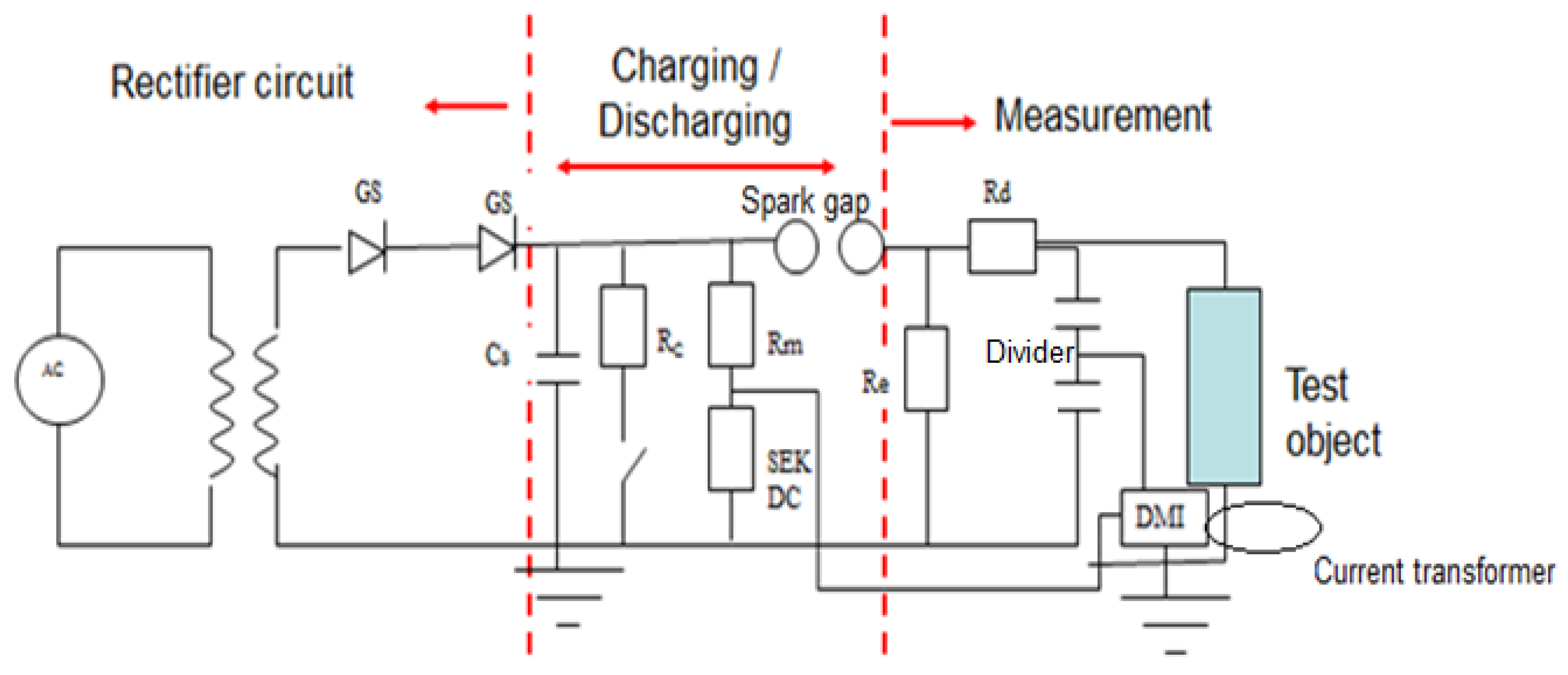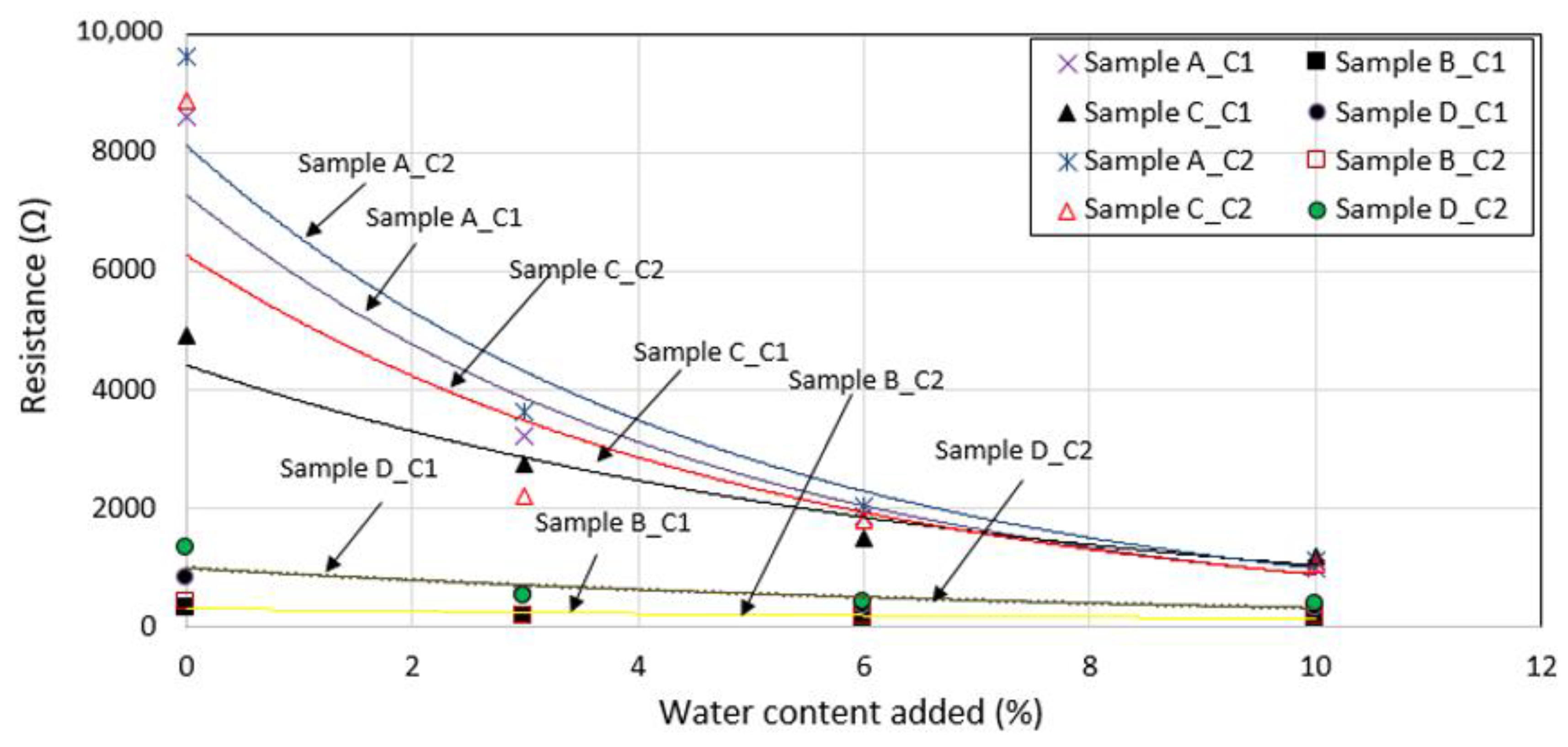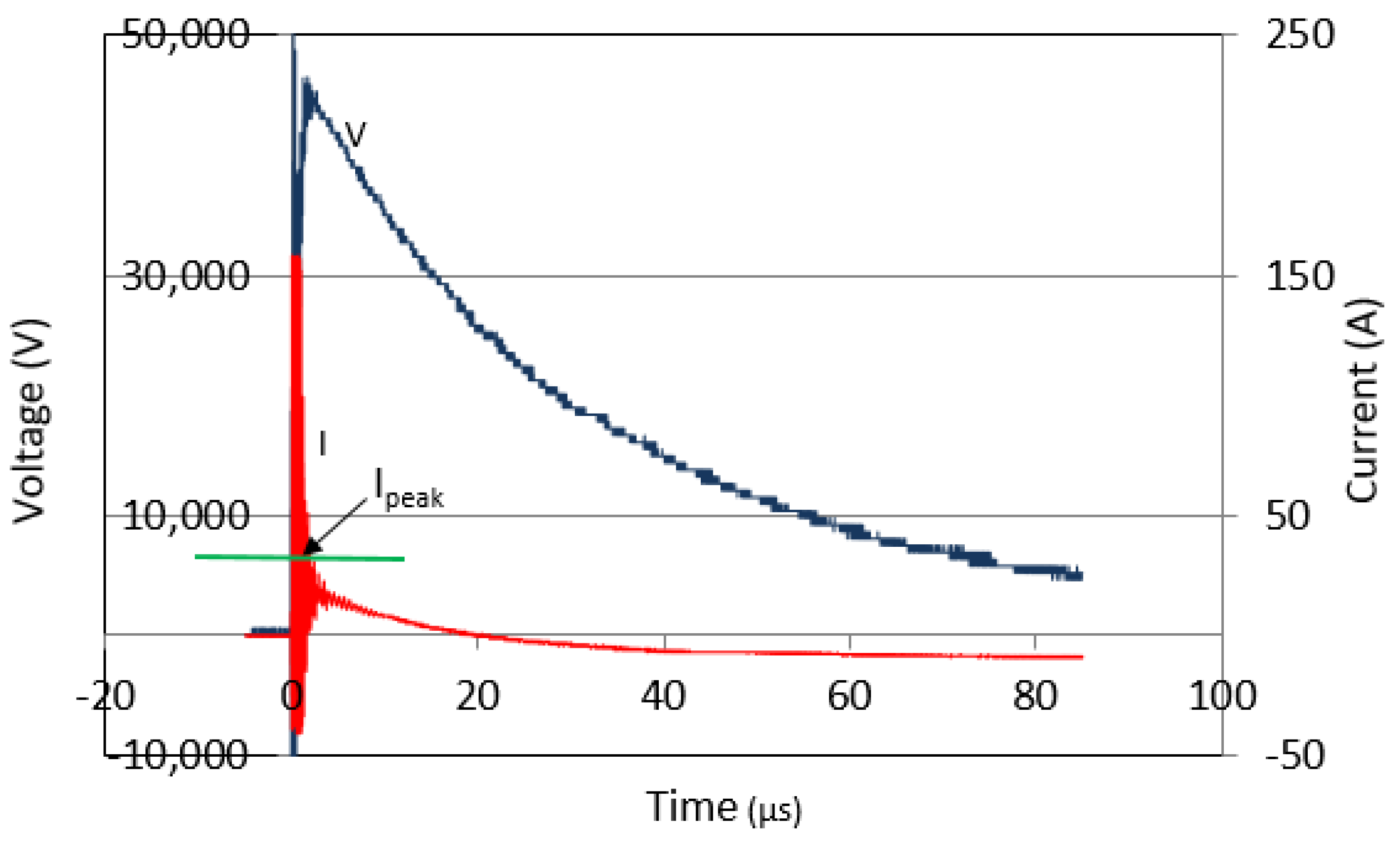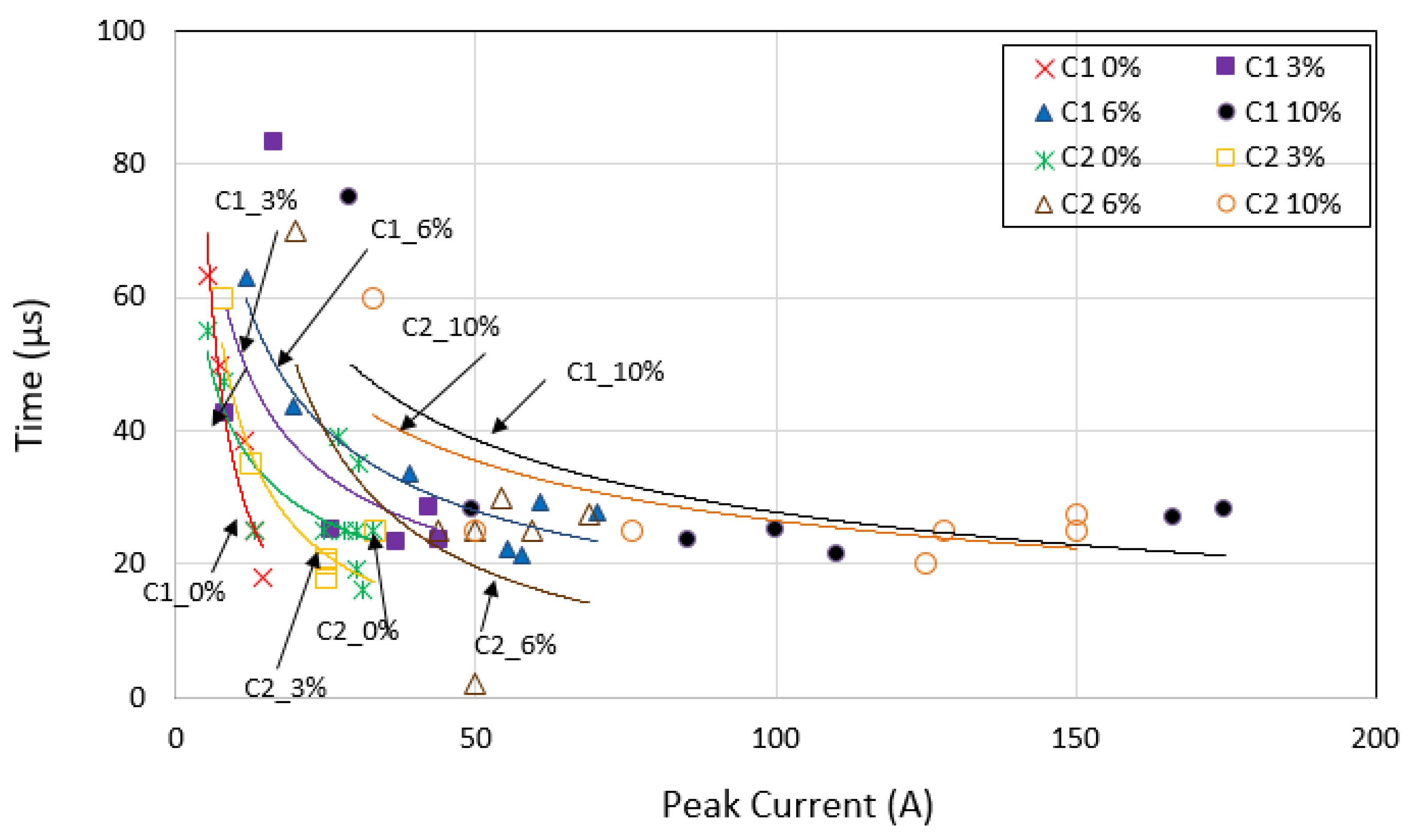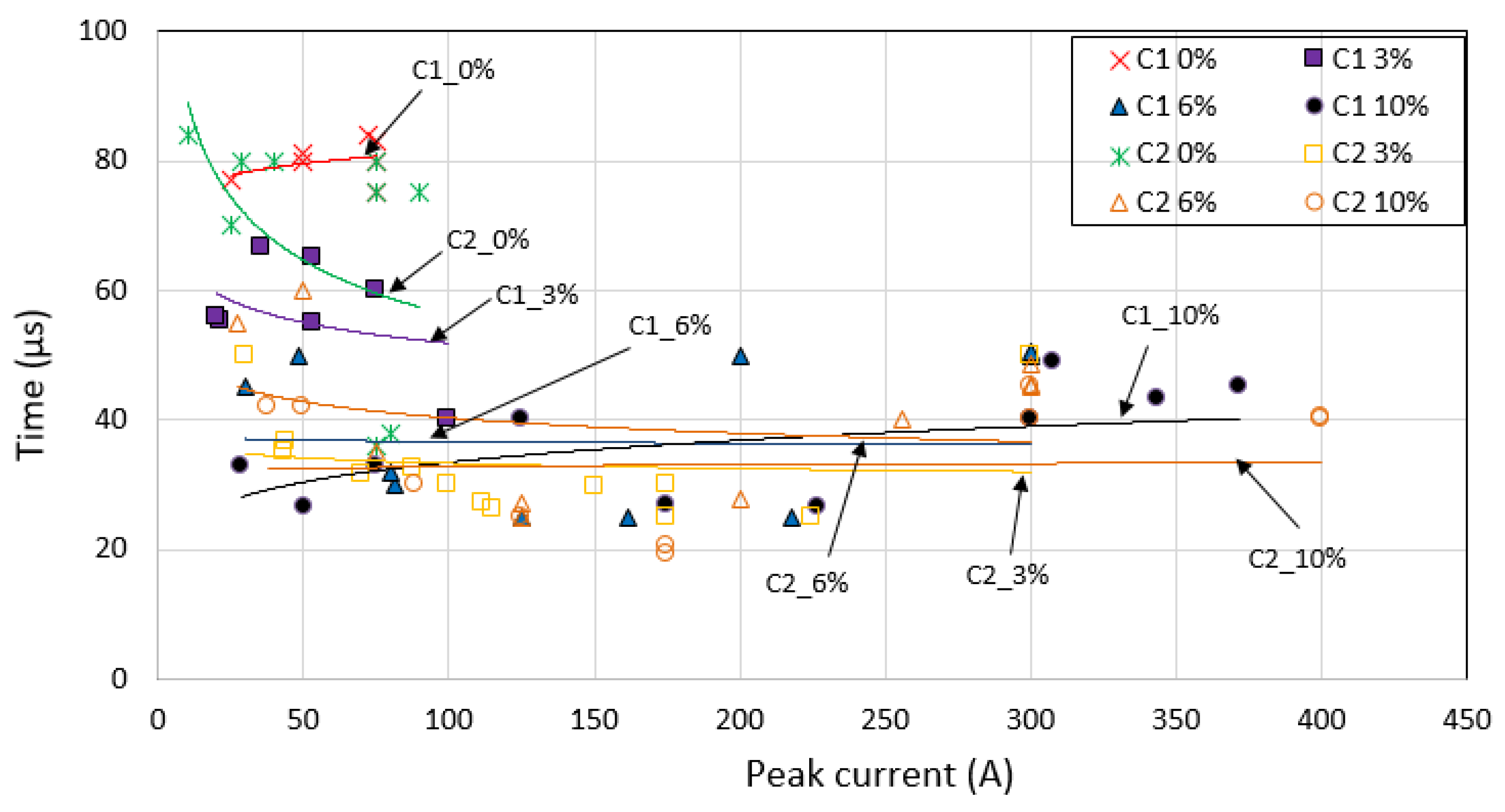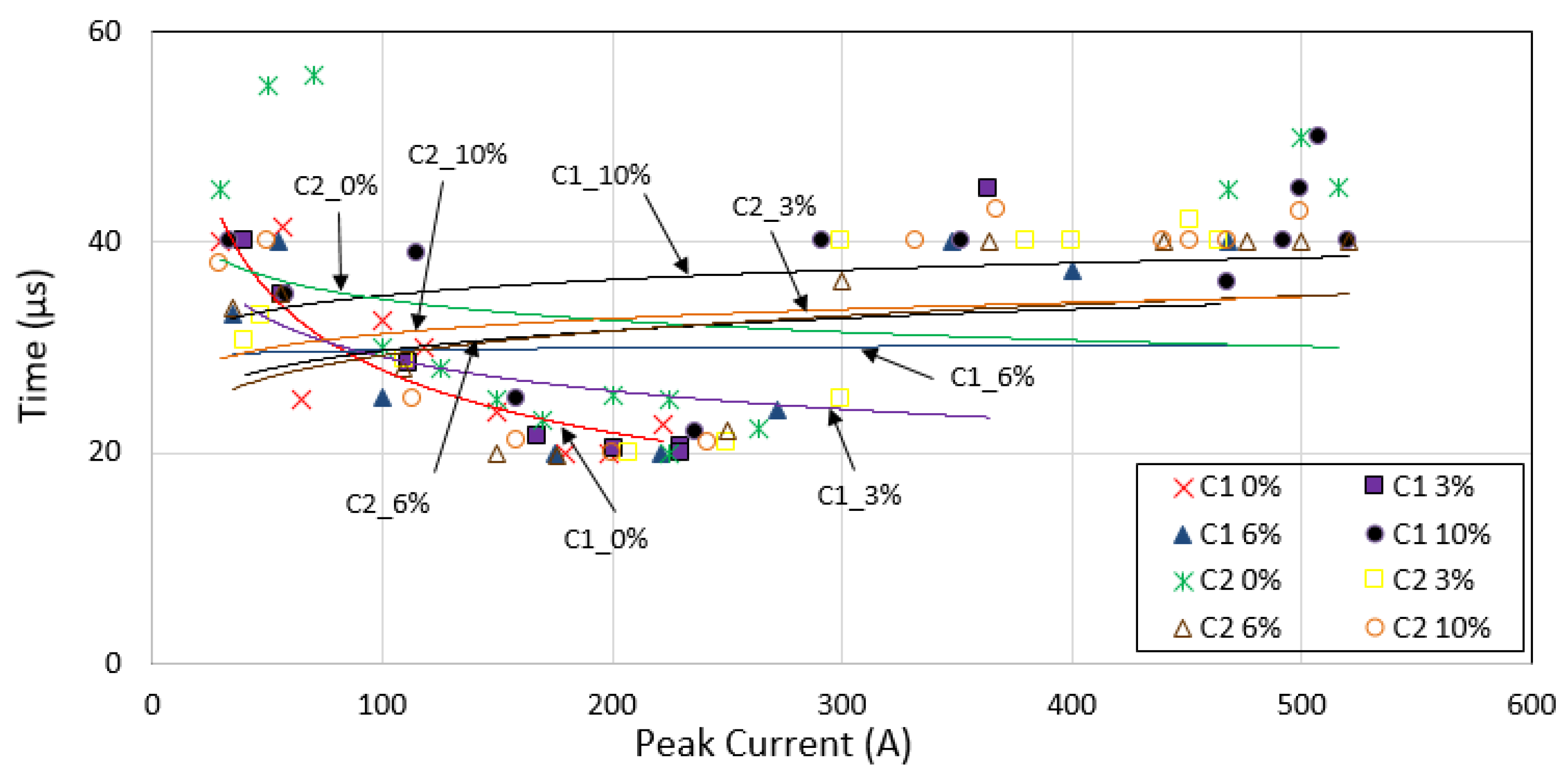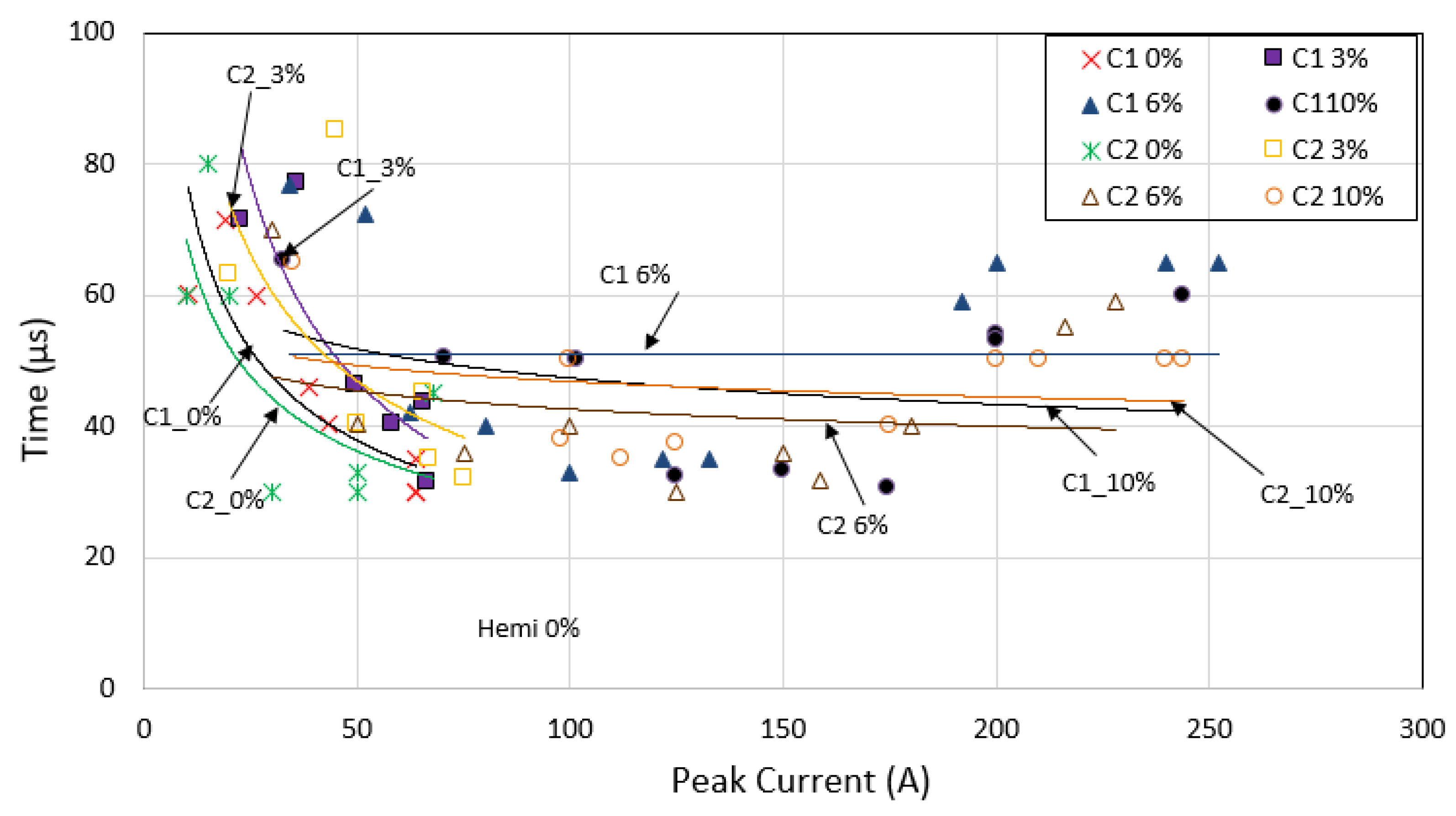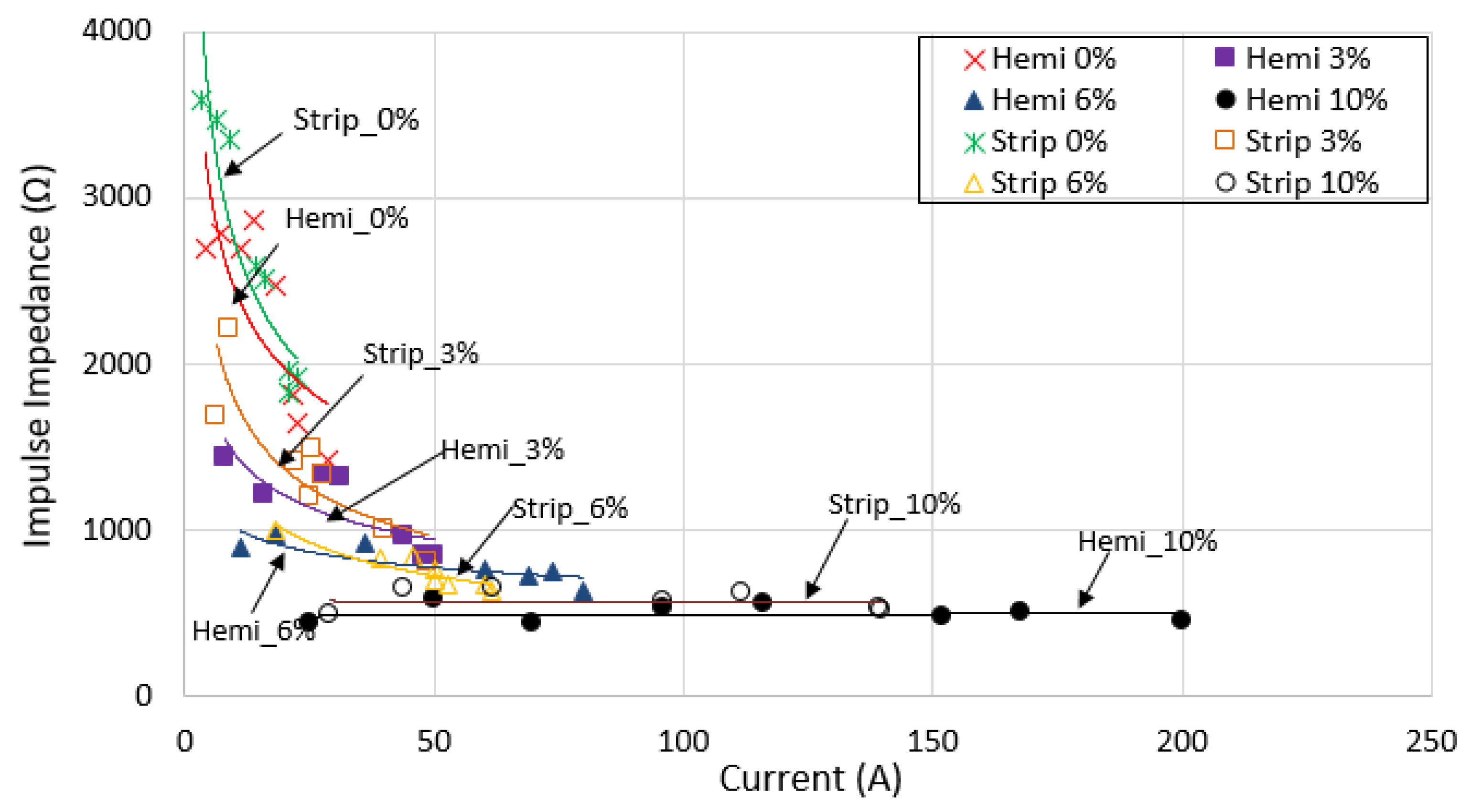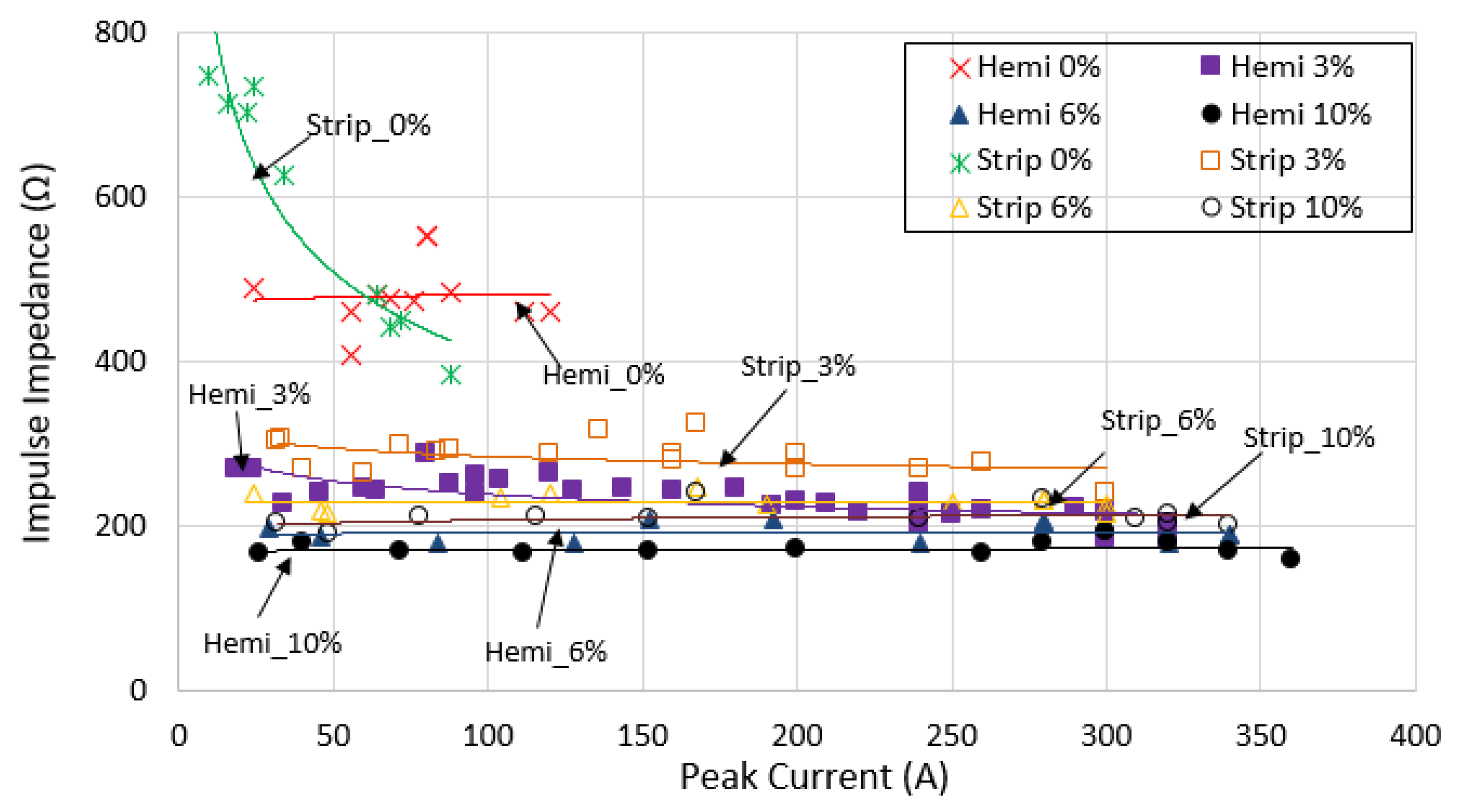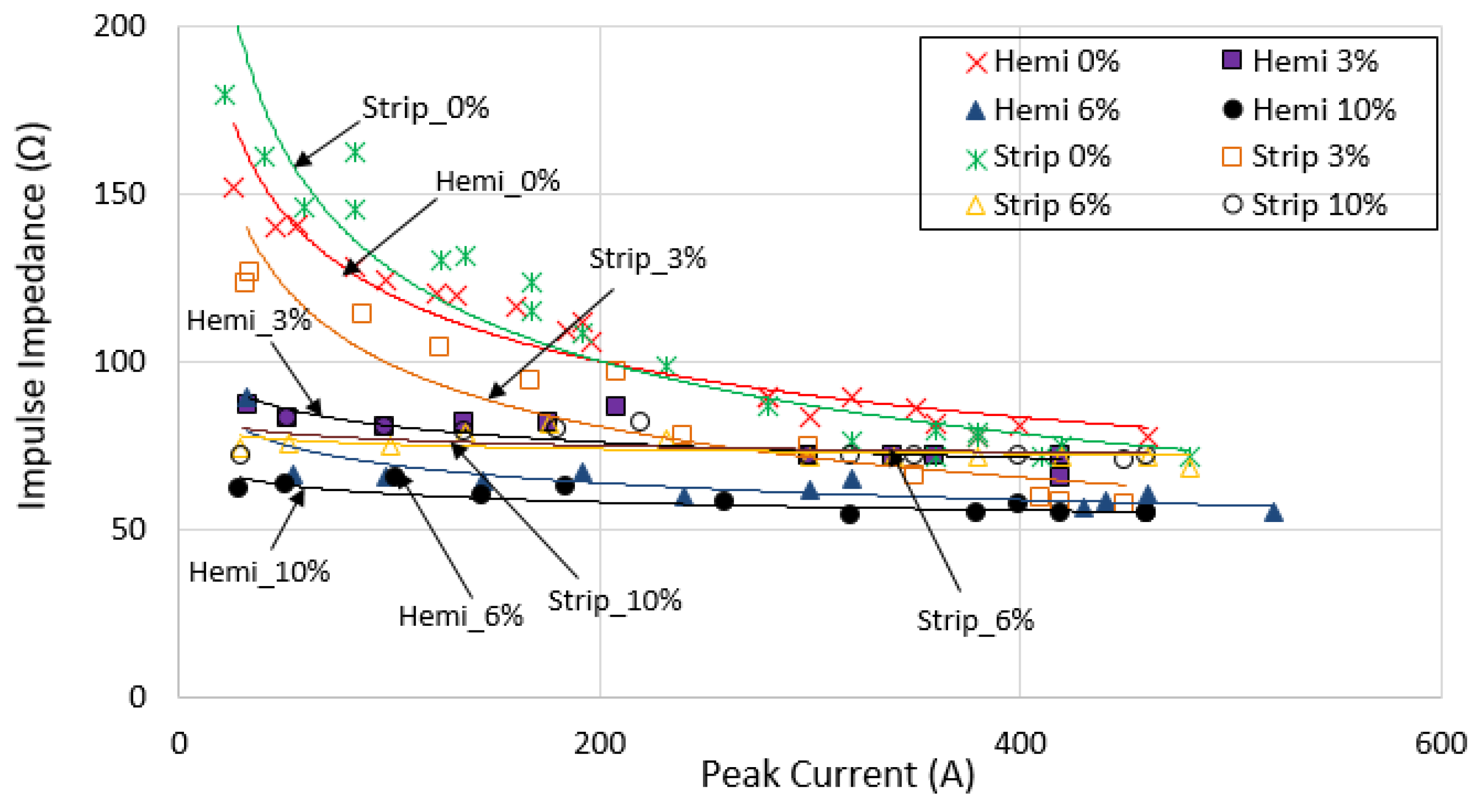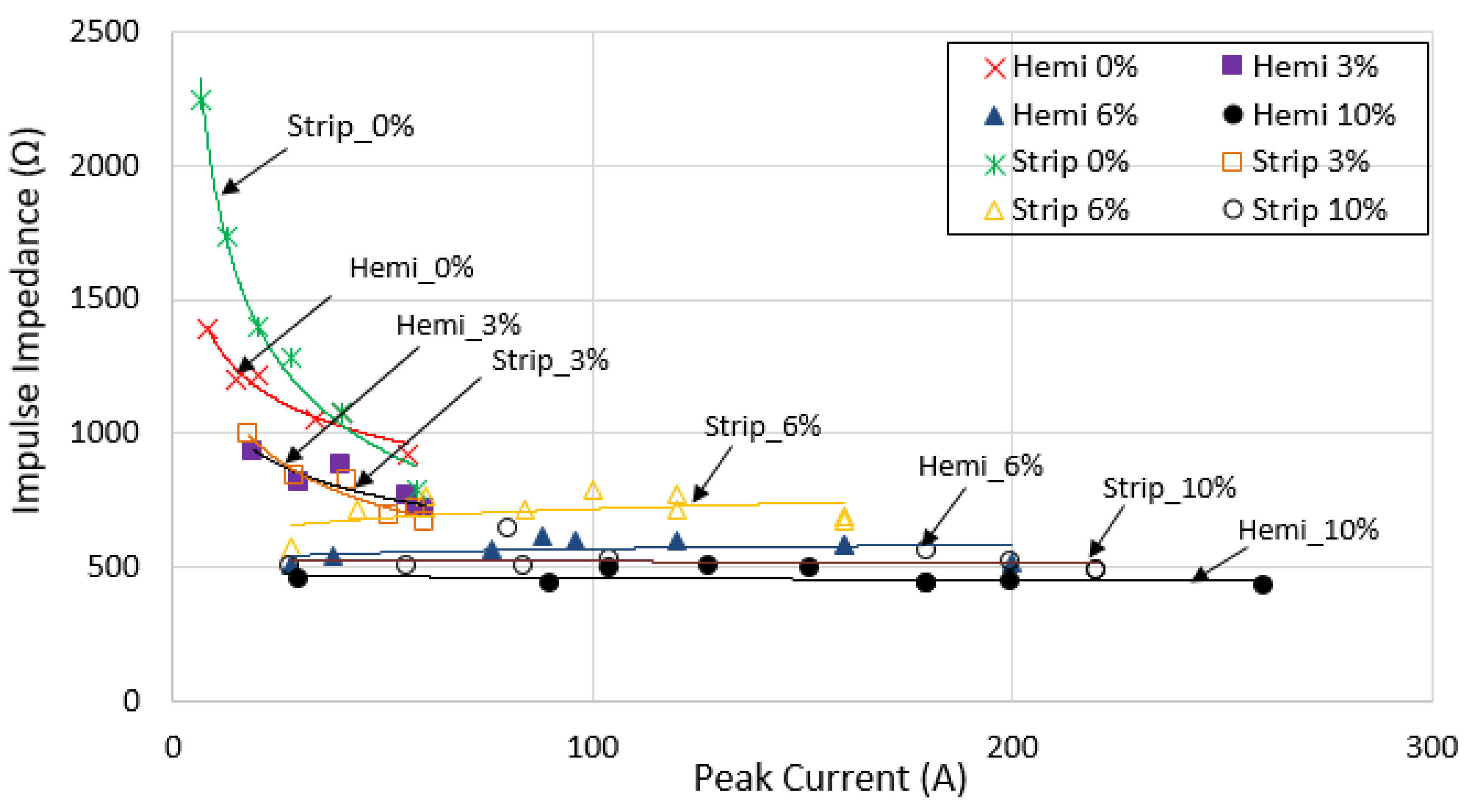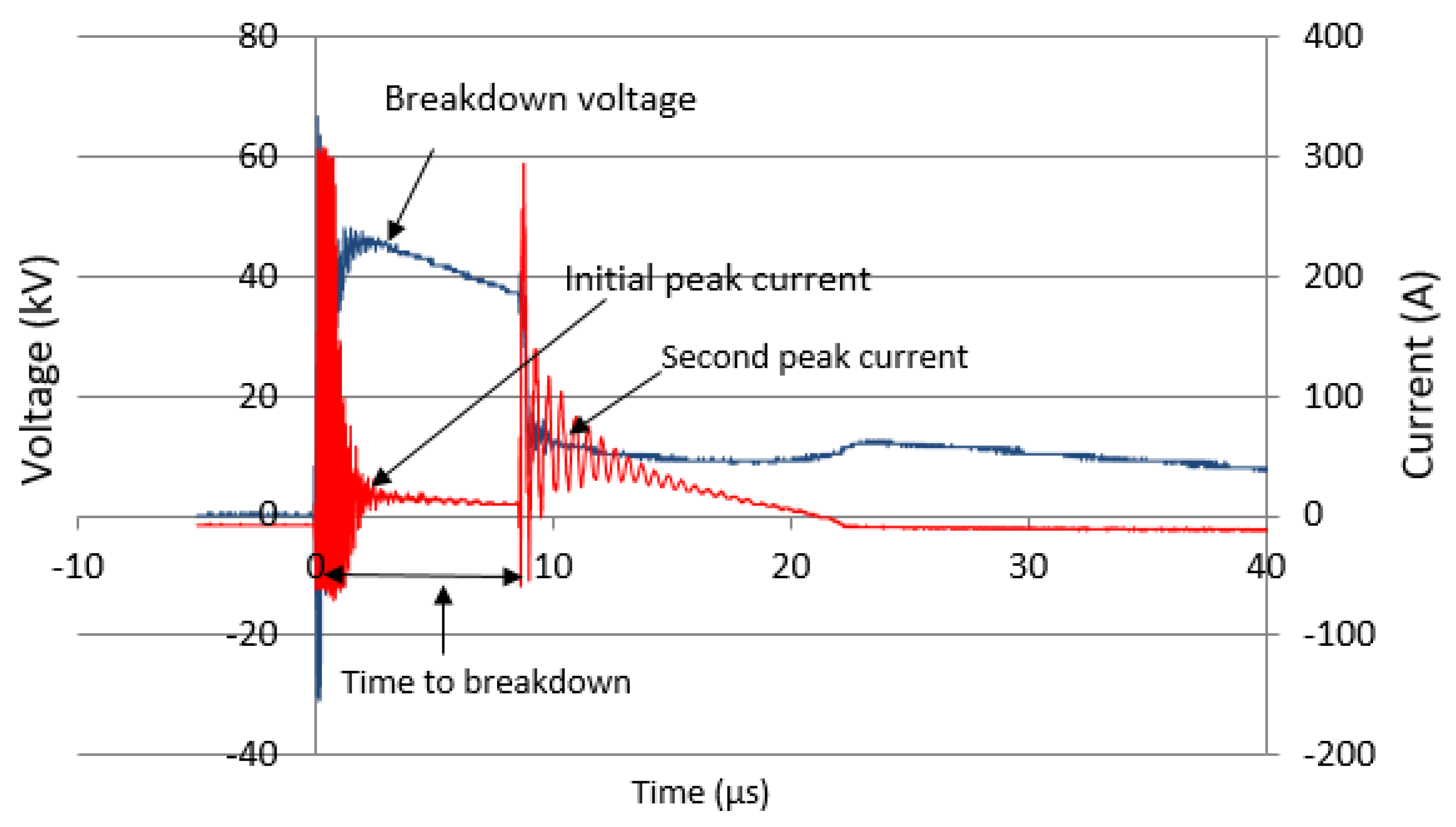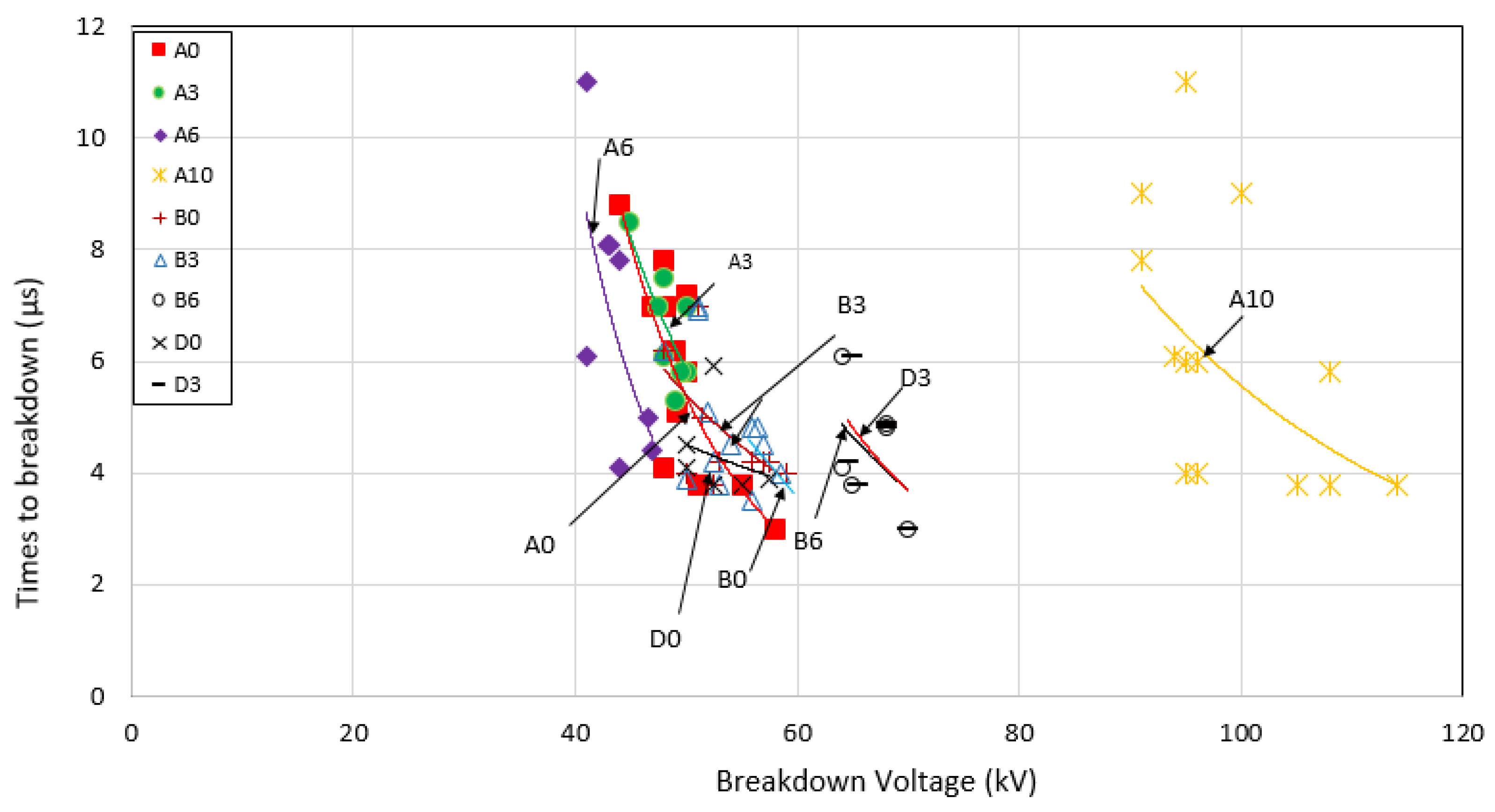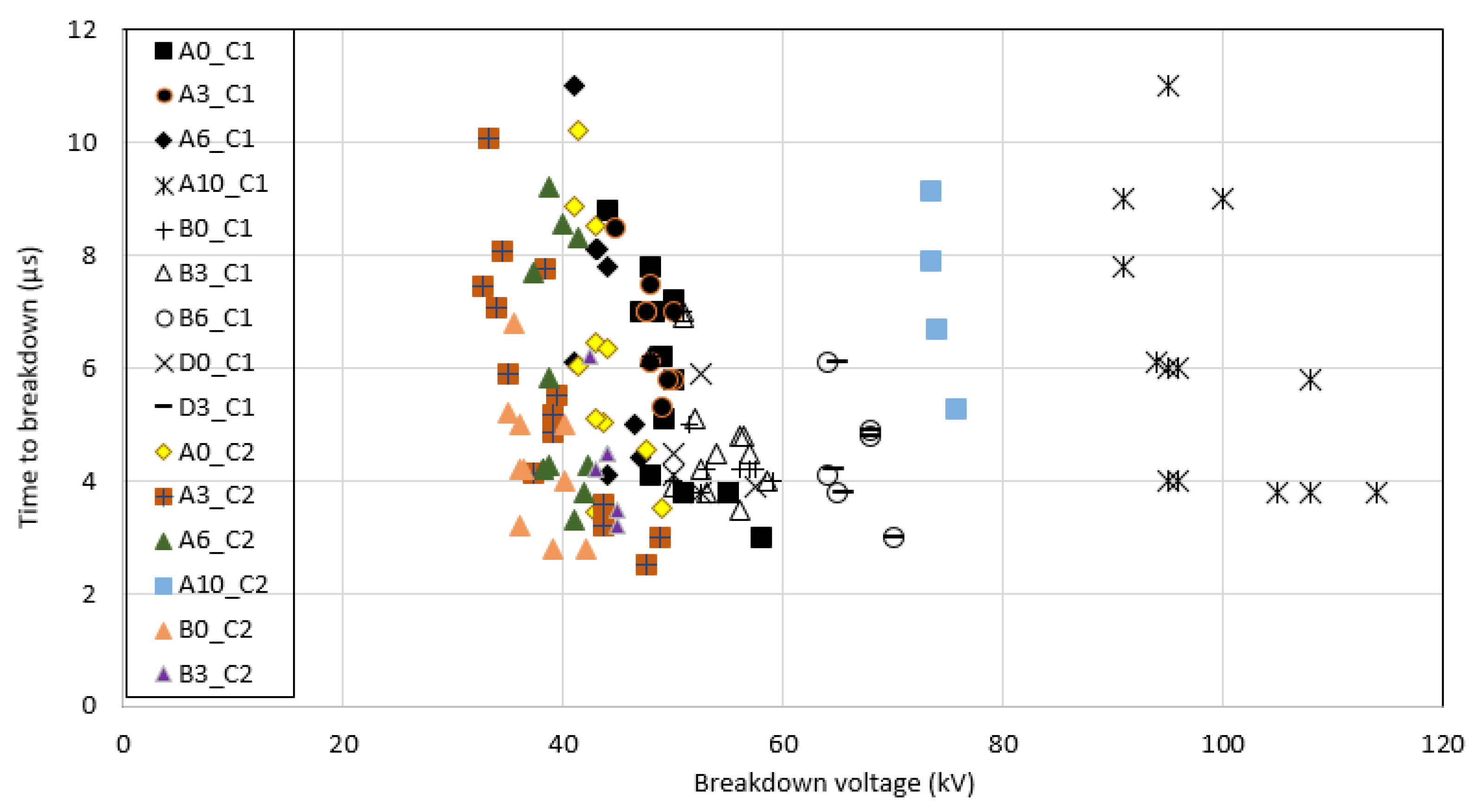1. Introduction
There have been various investigations [
1,
2,
3] on the effect of soil, among which are variations in the soil grain size, the moisture content in the soil, and a mixture with various percentages of salt and types of soil are investigated for laboratory tests, while the effect of soil resistivity [
4] and seasonal changes [
5] have been included in the study of the field tests on the soil characteristics under high impulse conditions. There are, however, several other parameters that may contribute to differences in soil properties, such as soil porosity, temperature and the percentage amount of colloids [
6], indicating that soil has a non-uniform soil resistivity. All these factors may also contribute to differences in the results from one study to another.
Extensive studies [
1,
2,
3,
4,
5] on the impulse characteristics of soil show a common finding, where an ionisation process in the soil would occur, and this ionisation process is initiated mainly in air voids in soil. Due to air discharges that occur in soil during the ionisation process, the effects of soil parameters on the impulse characteristics can be expected to be seen more clearly in large soil grain size, due to its large air voids. However, due to differences in soil grain size, among other factors, the results are found to be different from one study to another. This can be seen in [
1] who found that a clear difference in soil breakdown is seen in sand with grain sizes in a range of 1 mm to 19 mm, where a higher voltage level is needed to cause breakdown for negative impulse polarity than the positive impulse polarity. Due to air discharges in air voids that occur during the ionisation process, a higher breakdown voltage in negative impulse polarity than positive impulse polarity is expected. However, lower breakdown voltage in negative impulse polarity than positive impulse polarity is seen in small grain size sand, of below 0.4 mm. The same authors have also shown that a clear photographic difference is seen in large soil grain size in [
7], whereby, when subjected to the positive impulses, the discharge channels are initiated from the active electrode, while the discharge channels are initiated from the grounded electrode when subjected to negative impulse polarity. However, for a smaller grain size of sand, the discharge channels seen are propagated from the active electrode, under both impulse polarities. The study [
7] shows that more convincing results can be obtained on soil characteristics under high impulse conditions if a large soil grain size is used.
It was also demonstrated in a few studies [
1,
2,
8,
9,
10] that due to high enough electric field values—higher than the initial discharges in soil—a breakdown in the soil would occur, which is indicated in a sudden rise in current and a drop in voltage that is observed, similar to the voltage and current signals typically seen during the breakdown process in other insulating materials. The ionisation process in soil and the factors affecting it are well presented in published work, [
1,
2,
8,
9,
10,
11,
12,
13] however, the breakdown observation in soil is found to be limited, which would require higher electric field stress to be applied on the ground electrode and surrounding test media. For the soil ionisation process, it is understood that the discharges are initiated in air voids, where a lower electric field is expected for positive impulse polarity than negative impulse polarity. This is evident in [
8] who carried out impulse tests on six ground electrodes installed at the same practical site of high soil resistivity, above 1000 Ωm, and found that for the same ground electrode, a higher breakdown voltage is seen for negative impulse polarity than positive impulse polarity. An obvious difference in impulse polarity effect on the impulse breakdown level of the ground electrode, seen in [
8] could be due to high soil resistivity (presumably with a low percentage of water content, coarse types of soil with large grain size), where discharges in air voids may have taken place, thus giving a clear impulse polarity effect, as seen in air breakdown.
Fine work on impulse polarity effect on the breakdown characteristics of soil can be seen in [
1], who also found that higher breakdown voltage in negative impulse polarity than positive impulse polarity for the case of high resistivity sand having coarse grain size, ranged from 1 mm to 19 mm. An occurrence of breakdown can also be seen in [
9] when high impulse current magnitudes were performed on a few rod electrodes with various lengths, installed at the same in situ. In their measurements, two peak current peaks are observed for tests at high current magnitudes, where the R1 and R2 are based on the first and the second peak currents, respectively. However, due to a high electric field, at interfaces of electrode and soil, when ground electrodes are subjected to high current magnitudes, soil breakdown is thought to be initiated at an early stage, which can even be at the first peak current, hence making it difficult to quantify R1 and R2 accurately. Detailed analysis of the breakdown delay can be found in [
8,
10]. They [
10] found the measured time breakdown delay under negative impulse polarity is slower than when the ground electrodes are subjected under positive impulse polarity, which again supports the impulse breakdown characteristics in soil as similar to that in gases or air void discharges. From an extensive work carried out by He et al. [
10], on the impulse breakdown delay under influences of impulse voltage levels, soil moisture, soil temperature and soil density, they discovered that impulse breakdown time delays are slower in low magnitudes of impulse voltage, large percentages of water content in soil, low soil temperature and large soil density. On the other hand, Ref. [
10] found that the breakdown time delays are shorter in negative impulse polarity than the breakdown time delays of positive impulse polarity.
As mentioned in [
1,
2,
8,
9,
10,
11,
12,
13] and as expected, during the breakdown in soil, higher current magnitudes are produced, and smaller impulse impedance values are obtained, in comparison to the case of when only ionisation process in soil occurs. Further, from the breakdown characteristics in soil, information on impulse breakdown time delay can give important information of how fast the current is being discharged to the ground, and how effective the grounding system is under various conditions. Despite much-published work [
1,
2,
8,
9,
10] being directed towards the soil breakdown phenomenon, inconsistent results are seen from one published work to another. This can be due to many non-uniformities in the soil that lead to differences in the results, and also due to unclear observations of ionisation through voltage and current traces. This is also supported by Zhang et al. [
14], who show that the determination of the onset electric field of ionisation in soil should not be based on the voltage and current traces alone, but also with X-ray photos.
In this paper, despite the soil extracted from four different sites, with a variety of soil compositions, it was obvious that large grain soil size shows more realistic results, and is close to other published work, in comparison to small soil grain size. This study also suggests that to encourage ionisation and breakdown to occur in the soil, large soil grain size can be considered. This paper investigates sixteen test samples representing the local test media at sites, where variations in soil grain size are seen. A hemispherical test rig with two different inner electrodes is used, where, from the voltage and current measurement, the discharged times and impulse impedance values are obtained.
4. Conclusions
Experimental work on four test samples of various soil grain sizes, composition and the percentage of water content was carried out. With the resistance of the test cell measured at low voltage and low current magnitudes, RDC values decrease with an increasing percentage of water content, and the degree of decrease is found to be influenced by the soil grain size and soil composition. Despite the percentage of water content being more than 25%, a significant decrease in RDC values with an increasing percentage of water content is seen, particularly in the test sample with a large grain size.
When impulse tests were performed on all the test samples, the peak current occurred at approximately the same time as the peak voltage. The current trace was, however, found to discharge at faster times than the voltage trace for all test samples, indicating the non-linear characteristics of the test samples. A clear relation of the current discharged time with the increasing current was seen for test sample A of the largest soil grain size, mixed with various percentages of water contents, and where the higher the RDC, the slower the current discharged times are. Impulse impedance values were also measured and observed, showing that impulse impedance values decrease with increasing current magnitudes in test samples of high RDC. For test samples with low RDC, impulse impedance values are found to be independent of current magnitudes.
The study indicates that the soil with a large grain size provides better resistance reduction, and a clearer relation in terms of current discharged times, where the impulse impedance decreases with an increasing current more significantly. The presence of large air voids in soil offers a bridging of arc, which can lead to better conduction in soil. Despite the large soil grain size in soil giving less conduction at low current magnitudes, given consideration in this study, it shows that large grain size in soil tends to be more effective when impulse characteristics are taken into account.
It was also found that for the uniform soil configuration, where both inner and outer electrodes are hemispherical (configuration 1) low average breakdown voltage levels are seen in test medium A, which could be associated with large grain size in soil, allowing more discharges in air voids to take place. A clear relation on the effect of the percentage of water content on the soil, where the average breakdown voltage levels increase with a large addition of water content is also seen in test medium A, having the largest grain size. On the other hand, inconsistencies in the results are seen in other test media, with smaller grain sizes. When strip electrode was used (configuration 2) lower breakdown voltage levels were seen. Lower average breakdown voltage levels for configuration 2 is rather expected due to the non-uniformity of the test cell, hence weakening the electric field strength of the soil and its air voids. Lower average breakdown voltage levels for the C2 than the C1 are more obvious and consistent in test medium A, again due to its large grain size of soil. This shows that for the study of impulse breakdown in soil, a large grain size in soil should be considered to provide more consistent results, which is also demonstrated in other published work before.
When the time delays versus the average breakdown voltage are plotted, it was noted that the times to breakdown decrease slowly with breakdown voltage levels in all test media. The times to breakdown are found to be close for all test media, ranging from 3 μs to 11 μs, with an exception of test medium A with 6% and 10% of water content, where the times to breakdown are found to be slightly higher. However, no significant difference was seen for other test media, which again indicates that soil with large air voids is more suitable to be used in the study of discharges and breakdown in soil since it is generally known that air voids play a role in the discharges and breakdown in soil. This can be an important decision for consideration in the study of soil discharges and breakdown since there are many other parameters in the soil that can affect the results. With the consideration of having a large size of soil, the study of other parameters can be considerably more consistent and accurate.
From the above discussions, it can be concluded that breakdown is more plausible to occur at a lower voltage for:
soil with a large grain size;
soil with a small percentage of water content;
non-uniform electric field ground electrodes with sharp edges and points.
It can be said that despite all of these points being opposite to the standard design of grounding systems, where a soil of low resistivity values is more preferred, the paper clearly shows that the impulse breakdown characteristics are different, where the discharges in soil, that can lower down impulse impedance value and cause faster discharged time, are more effective in soil with large soil grain size, which can be made of gravel or high soil resistivity.
It is suggested that due to more discharge processes in soil with large air voids, soil with large soil grain size can be considered for the design of grounding systems since it can lower the impulse impedance values and provide a better discharge of current when grounding systems are subjected to high impulse conditions. This, of course, compromises the performance of grounding systems at low voltage and low-frequency currents.
